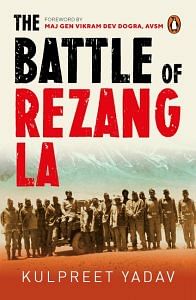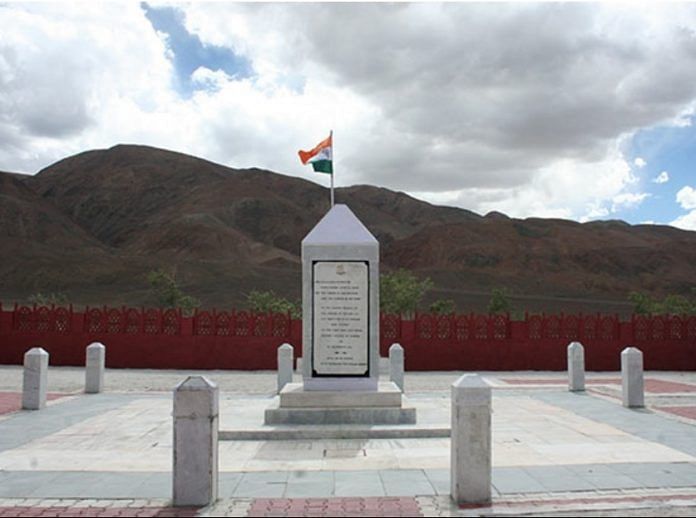Brig. T.N. Raina was in the operations room of 114 Brigade headquarters located in Chushul village near the airstrip when the first report of shelling on his brigade’s defence positions reached him. He had received information moments ago that the Chinese were pounding the 1/8 Gorkha Rifles posts on Gurung Hill.
Brig. T.N. Raina’s defensive plan was complete and according to his orders, the tanks, the MMGs and the artillery guns had started to retaliate to the Chinese firing in equal measure.
At the moment, the brigadier, along with his operations team, was busy preparing contingencies in case the Chinese did succeed in penetrating the Indian defence. He was planning alternate positions to defend, in case retreats became necessary, so that Chushul airstrip could be saved.
Also Read: Remembering Rezang La, a poignant moment of military courage on the western front
Gurung Hill is a mountain situated in the range that is spread between the origin of the Chushul River near Tsaka La, and 30 miles north to it, where it drains into the Spanggur Lake. While China considers this range as a watershed and therefore, a ‘traditional customary boundary’, India claims its boundary 10 miles eastwards, where it cuts across the Spanggur Lake following a more prominent watershed.
Between Gurung Hill, which lies to the north, and Maggar Hill, which lies to the south, is the 1.5 mile-wide gap called the Spanggur Gap. On the east of this gap, is the Spanggur Lake and on the north-west is the village of Chushul.
Like a crown, the Gurung Hill supports a long ridge line. This ridge grows from the base of the Spanggur Gap at 14,000 feet and spreads northwards, soaring to a height of 17,800 feet.
The ridge has a few flat sections towards its southern end and the Indian Army has given them interesting names like the Camel’s Back, the Table Top and the Bump. Right in the middle of the ridge, towards the east, is a mountain called Black Top (18,640 ft). Black Top was under Chinese control in November 1962.
Further on its north, Gurung Hill finally merges into another hill feature called Thakung Heights, the extremity of which is washed by the Pangong Tso Lake.
Also Read: Remembering the battle of Rezang La through the eyes of two brave soldiers
Gurung Hill was being defended by two companies of 1/8 Gorkha Rifles, less a platoon. It had a section each of MMGs and 3-inch mortars and was also supported by two troops of AMX-13 tanks of 20 Lancers located in the Spanggur Gap. As explained earlier, 1/8 Gorkha Rifles had withdrawn from Srijap and Yula posts a month before. These companies were now being commanded by Capt. P.L. Kher. One of the disadvantages of Gurung Hill was that it was dominated by the much higher Black Top, under the enemy’s control.
In addition, there was an artillery OP under the command of Second Lieutenant Shyamal Dev Goswamy. He had four trained jawans under him. This was the brigade’s most-heavily protected frontier because allowing access to this meant Chushul was within easy reach of the enemy.
Taking cover of their shelling, when a company strength of enemy soldiers was observed to descend from Black Top to positions held by the Gorkhas on Gurung Hill, Capt. P.L. Kher led the Gorkhas well, but he was seriously injured in the process.
In the meantime, Second Lieutenant S.D. Goswamy directed well-aimed artillery fire on the attacking Chinese. The young officer had ranged the enemy approaches well in advance and was ready for them. The firing stopped the Chinese soldiers in their tracks and as the Indian attack continued, they took shelter and returned to Black Top. The first wave had been defeated.
In the brigade’s operations room, at around 0700 hours, Brig. T.N. Raina turned his attention towards the positions held by 13 Kumaon. To find out the latest situation there, he ordered his operator to connect him to Lt Col H.S. Dhingra, CO, 13 Kumaon.
Also Read: Northern Army commander reveals how China was forced to negotiate Ladakh disengagement
Once the line was connected, he asked, ‘Colonel, how are your companies doing?’
‘Sir, all companies of 13 Kumaon are ready. So far, isolated bombs have fallen on Maggar Hill.’
‘What about our post at Rezang La?’
‘Even though there has been no communication since last night with the Charlie Company after the adjutant spoke to them, there have been no radio calls to report anything abnormal. The Chinese are busy on Gurung Hill, sir, as we can see.’
‘I agree, but what if they have launched a two-pronged attack? We had initially appreciated that they might attempt to penetrate the pass to block the Chushul–Tsaka La road. Remember, colonel?’
The CO of 13 Kumaon agreed that they must check the status of the Charlie Company. In the battalion headquarters of 13 Kumaon, Lt Col H.S. Dhingra placed the phone down and asked his operator to connect him with Maj. Jatar, the commander of Bravo and Delta Companies stationed atop Maggar Hill.
From the battalion headquarters, one could clearly see Maggar Hill, Spanggur Gap and the hills north of the gap like Gurung Hill, etc., but Rezang La, being on the south of the higher Maggar Hill, was not visible. Therefore, neither Lt Col H.S. Dhingra, nor any of the officers and JCOs of the battalion had a line of sight with Rezang La.
‘Major Jatar, how are your companies doing?’
‘Sir, we are safe. Just one injury so far to a cook. We have been shelled, but not heavily.’
‘That’s good, major.’
‘We are ready to defend our positions, sir.’
‘Great! What about Rezang La? We can’t see their positions from here, but you can. Their communication line is down too. How are they doing?’
‘Sir, like us they have been attacked too. We can hear sounds and see flashes. But I’m not sure of the exact situation on the ground.’
When the Chinese had attacked Rezang La, they had attacked Maggar Hill too. But unlike Rezang La, they had used only artillery on Maggar Hill, just enough bombs to pin them down in their trenches. There were no infantry attacks in the form of human waves on Maggar Hill. The only possible reason for this could have been that the Chinese wanted to keep the Indian soldiers stationed on Maggar Hill looking down while they carried out their business in Rezang La.
Also Read: India sits on Black Top with Helmet under its boots. A 1962 tactic by China is now likely
The CO continued, ‘Try them on the radio and get back to me.’
‘Roger, sir.’
Maj. Jatar was back in a few minutes, ‘Sir, there is no reply.’
‘Okay, send a patrol to Rezang La on foot and check.’
‘Roger, sir.’
This was the only option available to the CO even though covering the distance on foot would take them a total of at least six hours since the distance was around 5 miles. But it was possible that they would be able to communicate with the Charlie Company over the radio after just one or two hours and obtain an ‘all okay’ report.
On Maj. Jatar’s instructions, a patrol of four jawans was sent by the Delta Company to check the status of Rezang La and report as soon as possible. This patrol was led by Nk Roop Ram.
At around 0730 hours, a second wave of a battalion strength of enemy soldiers started to advance from Black Top. The Indians retaliated with intense artillery fire and tank ammunition, 3-inch mortars and MMGs. However, even this powerful firepower seemed underwhelming in the face of the sheer number of enemy soldiers.
Consequently, by 0930 hours, a portion of the Indian defences had been overrun. The Gorkha jawans fought valiantly and the Chinese suffered a large number of casualties, but the Chinese could not be stopped.
Even in the face of certain death, the artillery OP continued to engage the enemy with precision. At one stage, after Second Lieutenant Goswamy was wounded by shrapnel and lost consciousness, his second-in-command took over and continued firing the guns till the very end. Except for Goswamy, the entire observation party had been wiped out. The Chinese, after overrunning it, left Goswamy, thinking him dead. He would, however, be rescued the next day.
Also Read: If India loses grip on Kailash Range, PLA will make sure we never get it back
After the forward Indian positions on Gurung Hill had been run over, the enemy occupied the ridge and began to shell targets in the deep where the brigade headquarters lay.
The enemy kept on pushing ahead from the ridge, desperate and hungry, but the Indian firing from the tanks, led by Capt. A.K. Dewan, continued. Finally, after several hours of stalemate, the Indian tanks succeeded in puncturing the enemy’s resolve and stopping their advance.
The Chinese did not cross the ridgeline on Gurung Hill for the rest of the day.

This excerpt from ‘The Battle of Rezang La’ by Kulpreet Yadav has been published with permission from Penguin Random House.



